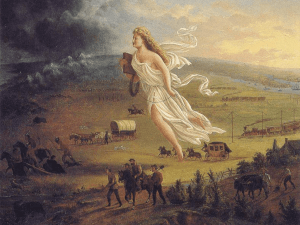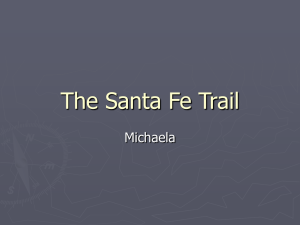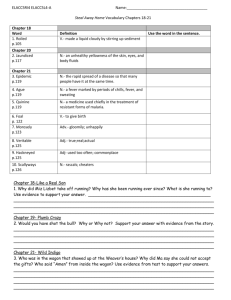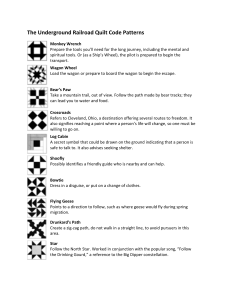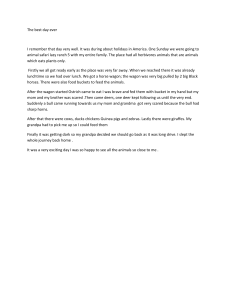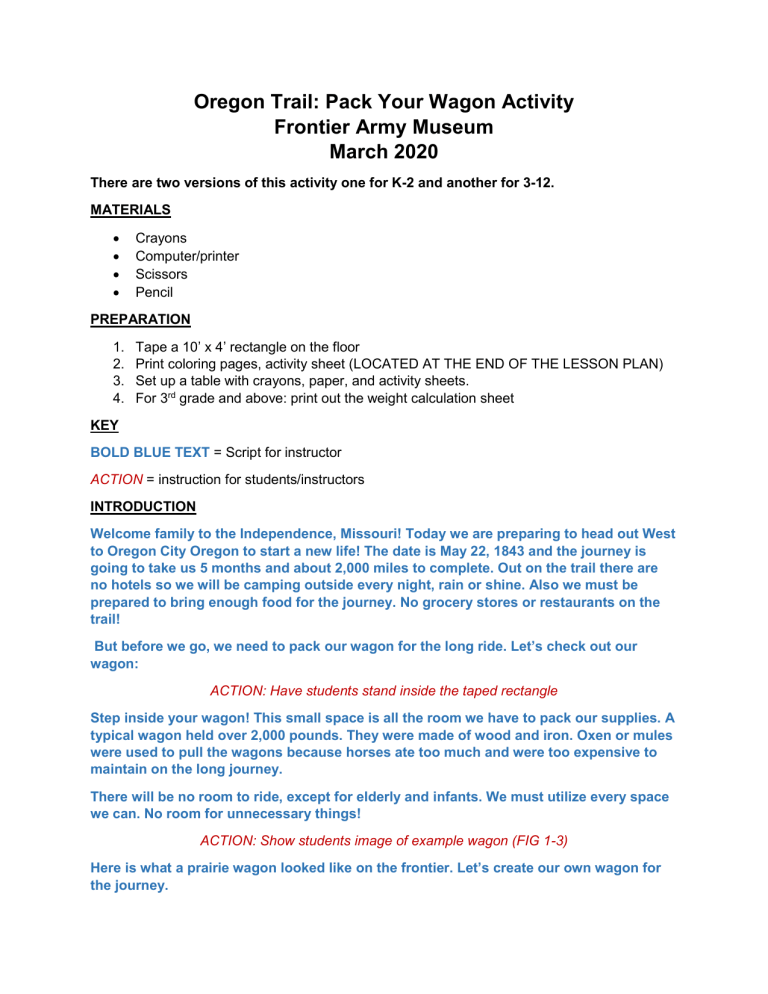
Oregon Trail: Pack Your Wagon Activity Frontier Army Museum March 2020 There are two versions of this activity one for K-2 and another for 3-12. MATERIALS Crayons Computer/printer Scissors Pencil PREPARATION 1. 2. 3. 4. Tape a 10’ x 4’ rectangle on the floor Print coloring pages, activity sheet (LOCATED AT THE END OF THE LESSON PLAN) Set up a table with crayons, paper, and activity sheets. For 3rd grade and above: print out the weight calculation sheet KEY BOLD BLUE TEXT = Script for instructor ACTION = instruction for students/instructors INTRODUCTION Welcome family to the Independence, Missouri! Today we are preparing to head out West to Oregon City Oregon to start a new life! The date is May 22, 1843 and the journey is going to take us 5 months and about 2,000 miles to complete. Out on the trail there are no hotels so we will be camping outside every night, rain or shine. Also we must be prepared to bring enough food for the journey. No grocery stores or restaurants on the trail! But before we go, we need to pack our wagon for the long ride. Let’s check out our wagon: ACTION: Have students stand inside the taped rectangle Step inside your wagon! This small space is all the room we have to pack our supplies. A typical wagon held over 2,000 pounds. They were made of wood and iron. Oxen or mules were used to pull the wagons because horses ate too much and were too expensive to maintain on the long journey. There will be no room to ride, except for elderly and infants. We must utilize every space we can. No room for unnecessary things! ACTION: Show students image of example wagon (FIG 1-3) Here is what a prairie wagon looked like on the frontier. Let’s create our own wagon for the journey. ACTION: Give students the line drawing wagon (FIG 4). Have students color and decorate their wagon. Come up with a family or team. Have fun! Now that our wagon is painted and prepped. We need to pack! We will be looking at two groups of items: food supply and dry goods. We must pack items from both groups to complete the journey. ACTION: Instructors – K-2: Hand out the coloring sheets (FIG 5) for students to color and cut out. Also hand out activity and question sheets. Grades 3-12: May also use coloring sheets. However, the additional math portion should be utilized for the activity. As you start to think about what you will bring, keep in mind Thousands of people traveled each year from May to October, covering 15 miles a day. There were no grocery stores or restaurants on the trail. Families needed to pack all of their supplies in the wagon before they journeyed out. A typical wagon held over 2,000 pounds and measured 10’ long by 4’ wide and 2’ deep. They were made of wood and iron. Oxen or mules were used to pull the wagons because horses ate too much and were too expensive to maintain on the long journey. Access to doctors and medical supplies was also limited. Pioneers had to care for the health and safety of their families the best they could. Life on the trail was tedious. For entertainment kids would read, play games, sing, and talk with friends. ACTIVITY – K-2 Pack Your Wagon! As a team you will pack a wagon for a family of 4. Color and cut out all of the available supplies. Review the shopping list below and their descriptions. Select 5 items from each list. Decide as a team what you will bring and place the cutouts into your decorated wagon. Consider these questions first: 1. What would be the most important things you would take with you? Why are they important? 2. Consider the options below. Rank them in order of importance (1 – very important, 6 not very important) __ Being hungry __ Feeling cold & wet __ Not having favorite or meaningful personal belongings __ Not feeling safe __ Being stranded __ Feeling bored List 1: Food Supply Item Apple Vinegar Description Used for food processing and canning, a topical antibiotic for cuts and scrapes, a flavoring ingredient Bacon Salted bacon was a good long term food product. It was a popular food subsistence on the trail. Beans Good source of protein. One sack of beans provides a large number of servings. Coffee Highly sought after good, great for a morale boost. Very popular with pioneers. Flour Used to make bread, hardtack, and cooking meats. Lard Used for cooking, similar to butter. Salt Used for cooking and preserving meats. Sugar Tea Used in baking and flavoring. Used to flavor water, began falling out of popularity after the War of 1812. Coffee became the more favored drink. Rice Water Used for cooking. The trail followed fresh waterways, however water was not always available. Dried meat Dried meat kept longer than fresh meat. Good source of protein. Eggs Good protein, used in baking and cooking. A fresh item that didn’t last long. Dried fruit Popular treat on the trail, dried fruit lasted longer than fresh. Cornmeal Used for baking and cooking. Eggs could be packed in cornmeal to protect them from breaking. Mark 5 items List 2: Dry good and sundries Item Description Bedroll Travelers camped out daily, rain or shine. Blacksmith tools Books Used to fix wagon parts and other items. Medicine In case of illness or disease. Many medicinal To alleviate boredom on the trail. treatments were homemade such as essence of peppermint, which was used to cure stomach aches. Cast Iron stove For cooking meals. Made of iron, very heavy Chair For comfort and to decorate the new home. Cookware Pots, pans and similar materials to cook food. Grandmother’s clock Gun making tools Box of toys Tells time, a precious family heirloom. Mirror A family keepsake, high value item. Gunpowder Needed for weapons but is explosive when exposed to To repair weapons if needed. Dolls, wooden toys, puzzles. fire. Tent Help protect from rain and outside weather during rest periods. Rope Tying down supplies inside wagon and various other uses. Fishing gear The trails followed waterways out West. Catching fish was a possibility in some areas. Extra clothing Pants, shirts, socks, and shoes. Life on the trail was tough on clothing, walking miles and miles a day took a toll on shoes and other clothing items. Music Instruments Listening to music was a popular method to help pass the time Mark 5 items After you made your choices answer the following questions: 1. What choices did the families have to make in order to prepare for the journey? What happened if they didn’t bring something that they later needed? 2. What were some responsibilities of the pioneers? 3. Why did people decide to travel out West? What were they wanting to find? 4. How did the Oregon Trail change our society? 5. What do you think happened to pioneers on the trail? SAMPLE ANSWERS AND KANSAS STANDARDS FOR INSTRUCTORS 1. What choices did the families have to make in order to prepare for the journey? What happened if they didn’t bring something that they later needed? The pioneers had to decide how much food and supplies to bring that would last the entire journey. The wagon can only carry so many things. By not choosing one item you may need it later. It was hard to plan what would happen. 2. What were some responsibilities of the pioneers? The travelers were responsible for packing the wagons for the long trip. They also had to care for their family and children. 3. Why did people decide to travel out West? What were they wanting to find? People traveled out West for land. They wanted land to farm and have animals. They were wanting to find a new life. 4. How did the Oregon Trail change our society? The Oregon Trail moved people out West. If people did not travel out West that part of the country would be much different then today. Less development, smaller cities. 5. What do you think happened to pioneers on the trail? I think the pioneers were very tired and bored. It was a long journey and they had to walk the whole time. Also they would have been bored because there was not much to do on the trail. Kansas History Standards 1. 2. 3. 4. 5. Standard 1: Choices have consequences. Standard 2: Individuals have rights and responsibilities. Standard 3: Societies are shaped by beliefs, ideas, and diversity. Standard 4: Societies experience continuity and change over time. Standard 5: Relationships among people, places, ideas, and environments are dynamic. ACTIVITY 3-12 Pack Your Wagon! As a team you will pack a wagon for a family of 4. Color and cut out all of the available supplies. Review the item description list Decide as a team what you should bring. Fill out the shopping list. Keep in mind that your oxen can only carry 2,400lbs without injury. Questions to consider as you decide: 1. What would be the most important things you would take with you? Why are they important? 2. Consider the options below. Rank them in order of importance (1 – very important, 6 not very important) Which option would bother you most? __Being hungry __Feeling cold & wet __Not having favorite or meaningful personal belongings __Not feeling safe __Being stranded __Feeling bored Read the below article from the St. Joseph, Missouri Gazette (March 19, 1847). This article was written to help assist families in packing their wagons. You may listen to the advice or make your own decisions. The choice is yours! But you have to decide as a team what you will bring. Mr. Editor, You will find a list of the items necessary for the journey to Oregon or California. It has been carefully prepared from previous travelers. The amount of supplies should be as follows for each person: 100 pounds of bread stuff (flour and crackers) 100 pounds of bacon 20 pounds of coffee 15 pounds of sugar 5 pounds tea 50 pounds rice 120lbs of beans 100lbs dried fruit 50 pounds salt No furniture should be taken, and as few cooking utensils as are necessarily needed. Every family ought to have enough supply of clothing for at least one year after their arrival. Some medicines should also be found in every family. I would suggest to each family taking a small sheetiron cooking stove. Good luck! Shopping list descriptions List 1: Food Supply Item Apple Vinegar Description Used for food processing and canning, a topical antibiotic for cuts and scrapes, a flavoring ingredient Bacon Salted bacon was a good long term food product. It was a popular food subsistence on the trail. Beans Good source of protein. One sack of beans provides a large number of servings. Coffee Highly sought after good, great for a morale boost. Very popular with pioneers. Flour Used to make bread, hardtack, and cooking meats. Lard Used for cooking, similar to butter. Salt Used for cooking and preserving meats. Sugar Tea Used in baking and flavoring. Used to flavor water, began falling out of popularity after the War of 1812. Coffee became the more favored drink. Rice Water Used for cooking. The trail followed fresh waterways, however water was not always available. Dried meat Eggs Dried meat kept longer than fresh meat. Good source of protein. Good protein, used in baking and cooking. A fresh item that didn’t last long. Dried fruit Popular treat on the trail, dried fruit lasted longer than fresh. Cornmeal Used for baking and cooking. Eggs could be packed in cornmeal to protect them from breaking. List 2: Dry good and sundries Item Description Bedroll Travelers camped out daily, rain or shine. Blacksmith tools Books Used to fix wagon parts and other items. Medicine In case of illness or disease. Many medicinal treatments were homemade To alleviate boredom on the trail. such as essence of peppermint, which was used to cure stomach aches. Cast Iron stove For cooking meals. Made of iron, very heavy Chair For comfort and to decorate the new home. Cookware Pots, pans and similar materials to cook food. Grandmother’s clock Gun making tools Box of toys Tells time, a precious family heirloom. Mirror A family keepsake, high value item. Gunpowder Needed for weapons but is explosive when exposed to fire. Tent Help protect from rain and outside weather during rest periods. Rope Tying down supplies inside the wagon and various other uses. Fishing gear The trails followed waterways out West. Catching fish was a possibility in To repair weapons if needed. Dolls, wooden toys, puzzles. some areas. Extra clothing Pants, shirts, socks, and shoes. Life on the trail was tough on clothing, walking miles and miles a day took a toll on shoes and other clothing items. Music Instruments Listening to music was a popular method to help pass the time Fill out the sheet with the amount of weight of each item you would like to bring. Add subtotals of each category for total overall weight. Remember the weight cannot exceed 2,400 pounds! FOOD SUPPLY Item Weight in lbs Apple Vinegar 25 Bacon 400 Beans 120 Coffee 80 Dried Fruit 100 Flour 500 Lard 200 Salt 50 Sugar 60 Tea 20 Rice 200 Water 100 Dried Meat 200 Eggs 50 Cornmeal 200 SUBTOTAL TOTAL weight of your wagon DRY GOODS & SUNDRIES Total lbs packed Item Bedroll Blacksmith tools Books Medicine Cast Iron Stove Chairs Cookware/utensils Grandmother’s Clock Gun-making tools Box of toys Mirror Gunpowder Tent Rope Fishing Gear Extra Clothing Music Instruments SUBTOTAL Weight in lbs 15 200 75 10 300 20 75 15 200 40 15 80 150 30 15 50 60 Total lbs packed After you have made your decisions, answer the following questions: 1. What choices did the travelers make to prepare for the journey? What are the consequences for choosing certain supplies over others? 2. What are the responsibilities of the travelers? 3. Why did American people decide to travel? What were they wanting to find? 4. How did the Oregon Trail change our society? 5. What are the human consequences of using or living by transportation routes in the 1800s? SAMPLE ANSWERS AND KANSAS STANDARDS FOR INSTRUCTORS / Grades: 3-12 1. What choices did the travelers have to prepare for the journey? What are the consequences for choosing certain supplies over others? Due to the limitations of the wagon, the pioneers had to consider what was important to bring on the trek westward. Stores were not vastly available on the trail so if supplies ran out it was unknown where the next place would be to resupply. 2. What are the responsibilities of the travelers? The travelers were responsible for their own supplies and the health and safety of their companions. 3. Why did American people decide to travel? What were they wanting to find? The pioneers traveled west in order to secure land. The land would allow them to build a new life to farm and raise animals. 4. How did the Oregon Trail change our society? As people expanded west, the areas began to develop cities, trade extended towards the coast with the construction of railroad tracks. Additionally new discoveries of land, plants and animals occurred as Americans expanded farther and farther west. 5. What are the human consequences of using or living by transportation routes in the 1800s? Life on transportation routes was tough. The pioneers would have had to rely on one another to make it through the difficult journey. Relationships were tested and strengthened on the trail. Additionally pioneers were isolated from large cities and thus they needed to fend for themselves and figure out ways to survive on their own. Kansas History Standards (4th, 7th, 8th) 1. 2. 3. 4. 5. Standard 1: Choices have consequences. Standard 2: Individuals have rights and responsibilities. Standard 3: Societies are shaped by beliefs, ideas, and diversity. Standard 4: Societies experience continuity and change over time. Standard 5: Relationships among people, places, ideas, and environments are dynamic. Kansas Math Standards Math (3.NBT.2) - Fluently (efficiently, accurately, & flexibly) add and subtract within 1000 using strategies (e.g. composing/decomposing by like base-10 units, using friendly or benchmark numbers, using related equations, compensations, number line, etc.) and algorithms (including, but not limited to: traditional, partial-sums, etc.) based on place value, properties of operations, and/or the relationship between addition and subtraction. Math (4.OA.3) - Solve multi-step word problems posed with whole numbers and having whole number answers using the four operations, including problems in which remainders must be interpreted. Represent these problems using situation equations and/or solution equations with a letter or symbol standing for the unknown quantity. Assess the reasonableness of answers using mental computation and estimation strategies including rounding. Additional Resources: National Park Service: https://www.nps.gov/oreg/index.htm National Trails Map: https://www.fs.fed.us/recreation/programs/trails/natltrails.pdf US Department of the Interior: https://www.blm.gov/programs/national-conservationlands/national-scenic-and-historic-trails/oregon Kansas Historical Society: https://www.kshs.org/kansapedia/oregon-california-trail/12161 History Channel Oregon Trail: https://www.history.com/topics/westwardexpansion/oregon-trail National Oregon/California Trail Center: https://oregontrailcenter.org/supplies FIGs 1-3 Prairie Wagon, CA 1840 part of the Frontier Army Museum’s collection. The driver would drive the oxen beside his team or perch himself on the lazy board (a stout board pulled out from underneath the middle of the wagon). The bucket on the side of the wagon was full of grease and made the wheels turn smoothly. This wagon was recovered from Watkins Mill, MO. Catalog No. 59.180.001 A peek inside the wagon. The box you see inside is a hygrothermograph. This is a tool that museum’s use to monitor the temperature and humidity in galleries for the protection of the artifacts. FIG 4 FIG 5 Dry goods and sundries Mirror Rope Gunpowder Books Blacksmith tools Gun making tools Musical Instruments Box of toys Clock Cookware Clothing Medicine Tent Bedroll Fishing Gear Stove Chair FIG 5 Food supply Flour Tea Salt Cornmeal Rice Coffee Beans Sugar Water Eggs Apple Vinegar Bacon Dried Fruit Dried meat Lard
